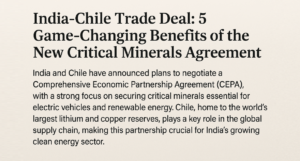India-Chile Trade Deal: 5 Game-Changing Benefits of the New Critical Minerals Agreement
India and Chile have announced plans to negotiate a Comprehensive Economic Partnership Agreement (CEPA), with a strong focus on securing critical minerals essential for electric vehicles and renewable energy. Chile, home to the world’s largest lithium and copper reserves, plays a key role in the global supply chain, making this partnership crucial for India’s growing clean energy sector. Prime Minister Narendra Modi highlighted the need to build resilient supply and value chains, while Chilean President Gabriel Boric Font is on a state visit to India to strengthen bilateral ties.
India currently imports large amounts of copper ores and concentrates from Chile, but as its lithium-ion battery industry expands, securing a stable lithium supply will become a priority. Trade between the two nations reached $3.8 billion in 2024, a sharp rise from $1.5 billion in 2020, driven by increased demand for metals and minerals. The proposed CEPA follows the 2016 expansion of the India-Chile Preferential Trade Agreement (PTA), which broadened trade opportunities across 2,829 tariff lines. India is also exploring Greenfield and Brownfield mining investments in Chile, aiming to deepen business-to-business (B2B) and government-to-government (G2G) collaborations.
As India pushes forward with its National Critical Minerals Mission (NCMM), a strategic partnership with Chile could ensure a secure and sustainable supply of key raw materials for its growing technology and energy industries.

India-Chile Trade Deal: 5 Game-Changing Benefits of the New Critical Minerals Agreement
India and Chile have agreed to initiate discussions on a Comprehensive Economic Partnership Agreement (CEPA), a move aimed at strengthening trade ties and securing access to critical minerals like lithium and copper. Prime Minister Narendra Modi announced the decision during Chilean President Gabriel Boric Font’s state visit to New Delhi, underscoring the strategic significance of this collaboration for both nations.
Why Chile Matters
Chile holds the world’s largest reserves of lithium and copper—minerals essential for manufacturing electric vehicle (EV) batteries, renewable energy systems, and electronics. As the global shift toward clean energy accelerates, securing these resources has become a top priority. Chile’s role as a leading global supplier positions it as a key partner for India, which is rapidly expanding its EV and renewable energy sectors.
During their meeting, PM Modi emphasized the need to establish “strong and reliable supply chains” through the proposed CEPA. He also expressed India’s interest in sharing expertise in renewable energy, digital infrastructure, railways, and space technology with Chile. President Boric, on his first visit to India (April 1–5), is set to engage with business leaders in Mumbai and Bengaluru to explore economic opportunities.
Strengthening Trade and Mining Ties
India and Chile already share a growing trade relationship. Chile is India’s fifth-largest trading partner in South America, with bilateral trade reaching $3.8 billion in 2024—up significantly from $1.5 billion in 2020. India primarily exports vehicles, pharmaceuticals, and machinery to Chile, while imports are dominated by copper ores, scrap, and molybdenum. Notably, India does not currently import lithium from Chile but is keen on securing future supplies to support its emerging lithium-ion battery industry.
To deepen cooperation, India’s Union Minister of Coal and Mines, G. Kishan Reddy, met with Chile’s Mining Minister, Aurora Williams, to discuss potential partnerships in mineral exploration and mining projects. Indian companies are eager to invest in Chile’s mining sector, including both new and existing lithium and copper ventures. Previous collaborations—such as a 2023 visit by India’s Mines Secretary to assess Chilean copper mines and a 2024 lithium exploration deal between India’s KABIL and Chile’s ENAMI—highlight the growing synergy between the two countries.
Building on Past Agreements
The push for a CEPA follows the expansion of a 2016 Preferential Trade Agreement (PTA), which increased the number of products eligible for reduced tariffs from 474 to over 2,800. The proposed agreement aims to further eliminate trade barriers, encourage investment, and secure India’s access to critical minerals.
India’s National Critical Minerals Mission (NCMM) seeks to ensure a stable supply of essential minerals for the country’s clean energy and technology sectors. A formal partnership with Chile could help stabilize these supplies, reduce dependency on other nations, and support India’s goal of achieving net-zero emissions by 2070.
What’s Next?
The CEPA negotiations are expected to foster stronger government and business collaborations. For India, access to Chilean lithium and copper could accelerate its EV adoption and renewable energy projects. For Chile, partnering with India offers opportunities to diversify export markets and attract investments in mining technology and infrastructure.
As both nations navigate the global energy transition, this partnership could set a benchmark for sustainable and mutually beneficial economic cooperation. With Chile’s abundant resources and India’s technological prowess, this alliance has the potential to reshape supply chains and drive innovation in critical sectors.
In Summary
- CEPA Talks: Focused on critical minerals, trade expansion, and investment.
- Trade Growth: Bilateral trade surged to $3.8 billion in 2024, driven by copper imports.
- Mining Investments: Indian firms are eyeing Chilean lithium and copper projects.
- Future Goals: Stabilizing mineral supply chains to support India’s clean energy ambitions.
This partnership marks a strategic step for India in securing essential resources for its green future while creating new economic opportunities for Chile in one of Asia’s fastest-growing economies.
You must be logged in to post a comment.